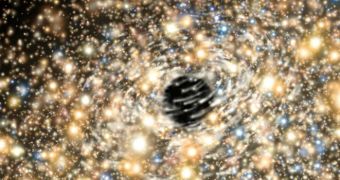Extremely bright quasars could degenerate into supermassive black holes over the course of billions of years, experts say after studying a pair of dark behemoths that exceed any other known black hole in terms of mass and size.
Quasars are the highly-active cores of distant active galactic nuclei, and they can be seen primarily in extremely old galaxies. As their homes degenerate due to lack of new stellar formation, it could be that these quasars turn into what we now understand to be a supermassive black hole.
The process would be rather simple, say investigators at the University of Michigan, as it would only involve the quasar losing the material surrounding the actual black hole. Usually, this material is heated up and emits radiations, which is why the quasar appears to be bright when viewed from far away.
The new study could be used to draw new conclusions on how quasars evolve over time, but also on how they formed when the Universe was extremely young.

 14 DAY TRIAL //
14 DAY TRIAL //